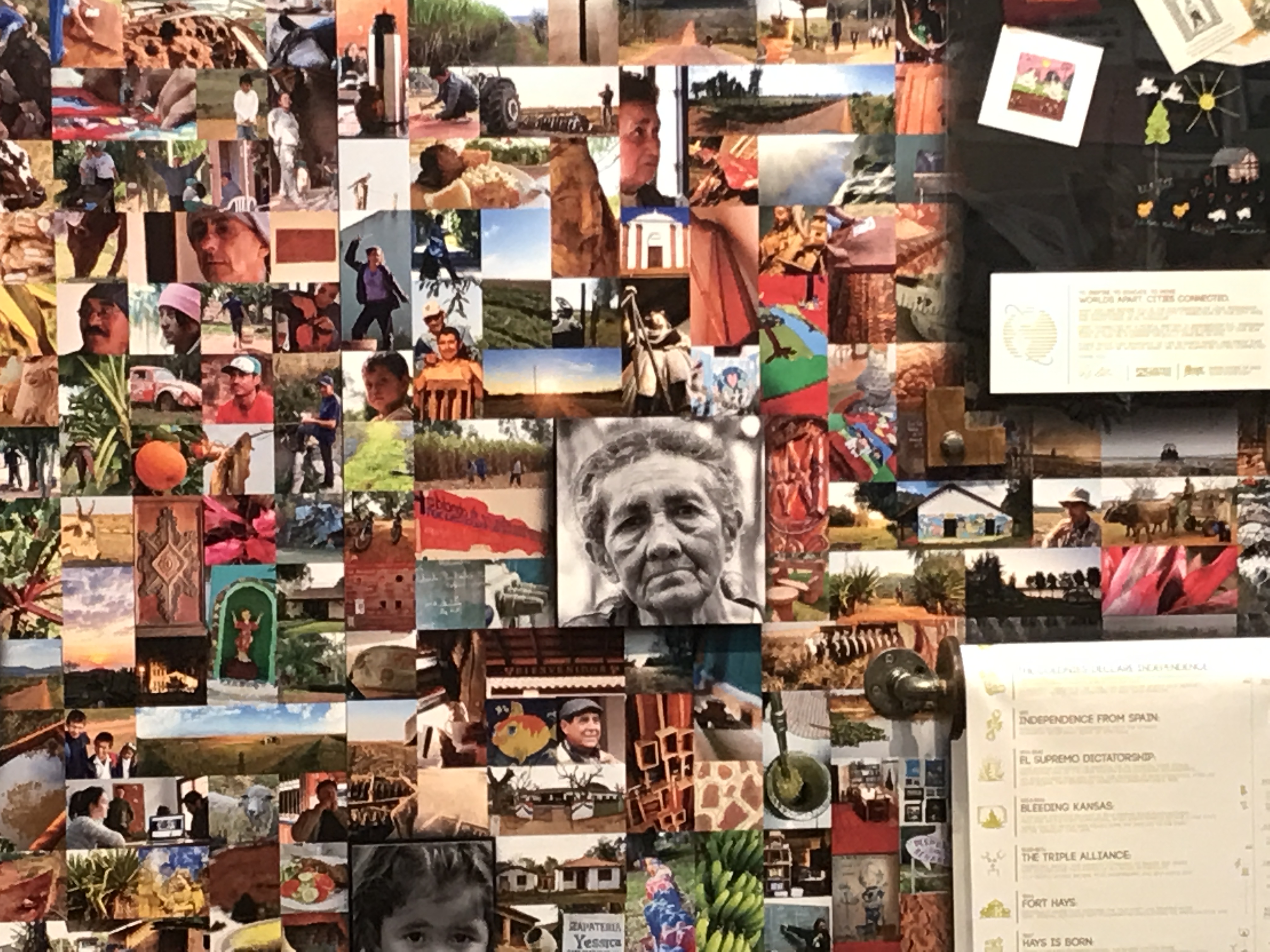By CRISTINA JANNEY
Hays Post
Hays residents and four members of a delegation from Santa Maria de Fe gathered at the Hays Public Library Saturday afternoon for a presentation and dedication of an art installation “World Apart, Cities Together” honoring Hays’ sister city.
Milciades Ramon Mancuello, tourism coordinator, Erma Elizabetk Del Puerto de Ramirez, director of Institute of Technology, Isabelino Victor Martinez Galiano, manager of Jesuit’s Museum and Derlis Hernan Maidana Zarza, governor of Misiones, are visiting the city in honor of the city of Hays’ 150th birthday.
The group attended many events during the sesquicentennial this week, including the Hays City Commission meeting Thursday night.
Hays and Santa Maria became sister cities in 1976. Although there had been exchanges back and forth since that time, the sister city organization began working in earnest to renew the partnership between the two cities in 2001, culminating with the four dignitaries’ visit to Hays this weekend.
Del Puerto de Ramirez gave a presentation to a group gathered at the library about her home city.
Santa Maria has about 10,000 residents in the surrounding area with an economy that is based on agriculture, meat production, industry and fine arts.

The community has 25 elementary schools, seven middle school/high schools and one technological institute, which Del Puerto de Ramirez is the director.
Max Maximov, Sister Cities board member, has traveled to Santa Maria and said in introductions of the Hays group has tried to help the schools in Santa Maria.
The Santa Maria school district has about 925 students, but only 45 computers, and those are from the 1990s. The Hays Sister Cities group tried unsuccessfully to obtain a grant to buy new computers for the schools.
Students in Santa Maria are studying English, which allows them to take tests that would allow them to study in the United States or the United Kingdom. About 90 students have passed the British Cambridge test, and 178 students are studying English at various level at this time.
Santa Maria hopes to soon have a branch of the state university, Del Puerto de Ramirez said through Maximov, who was interpreting. Transportation proves to be a large barrier for students to reach university branches in other communities.
The technical institute is privately funded. A British journalist traveled to the community and fell in love with the city and its people. She helped set up a charity in Britain that helps fund the institute, which offers classes to its students for free.
The technological institute’s two-year program focuses on food production and packaging. The students are working with the municipal meat packing plant on quality control.
The institute also has worked with local residents to identify and cultivate medicinal plants and vegetables and improve nutrition.
Paraguay produces some herbs that are shipped all other the world. Production has picked up as people have become more aware of the use of alternative medicine.

Homes in Santa Maria are equipped with brick ovens called tatakuas, which translated into English literally means “fire where.” Del Puerto de Ramirez noted the ovens provide a superior taste in food than a flat top stove.
The city of Santa Maria is also known for its rich cultural history and fine arts. Santa Maria was established by Jesuit priests in 1631. Isabelino Victor Martinez Galiano, is manager of Jesuit’s Museum, which was created with a donation by Marianna Beach.
Today the museum preserves many of the religious artifacts from early Santa Maria. Martinez Galiano showed photographs of the museum and its art, which included life-size statues of the early priests, a nativity, angels, and complete statuary depiction of the passion of Christ.
Donations were taken for the museum during the art dedication Saturday.

The art installation is in the lobby of the Hays Public Library. It includes photos taken in Santa Maria by Cody Custer. The installation also includes examples of hand embroidery and a scroll documenting both the histories of Hays and Santa Maria.
Martinez Galiano talked about his impressions of Hays.
“We have found a lot of calm and a lot of tranquility and humans that are very similar to our own ,” he said through a translator. “We have seen that the city is very connected to the land … to agriculture. People are very proud of their work and have good organization.”
 Martinez Galiano met with members of the art department during his visit.
Martinez Galiano met with members of the art department during his visit.
He said there are many people in Santa Maria who have art inside them, but they do not have the opportunity to let it out. In Hays there is an opportunity.
He said the biggest difference between Hays and Santa Maria is its approach to education.
“Education is so much present here that it is first importance, second importance and third importance,” he said.
He said he hoped the two cities can continue to cooperate culturally, and there would opportunities for both young people and adults.
Martinez Galiano said he has learned about the history of Hays, which is very different than that of Santa Maria. Santa Maria was indigenous and then religious. Hays went through many different levels of development and was influenced by different cultures.
Ramon Mancuello said he thought Hays was a small community like Santa Maria, but was impressed by its size when he arrived.

“We have met kind people, very friendly people and everybody knows each other,” he said.
Ramon Mancuello said in this way, Hays is very similar to Santa Maria.
